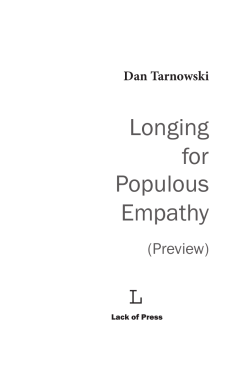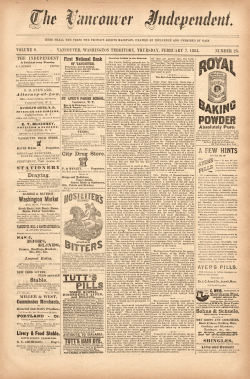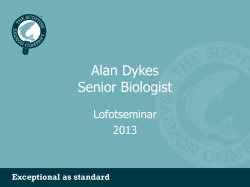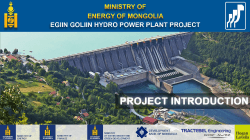
Fisheries impacted by run-of
OF HYDROPOWER AND STREAMS A tale of run-of-river hydropower facilities and their possible impacts on fish populations The impacts of ‘run-of-river’ hydropower on the physical and ecological condition of rivers Anderson et al, 2014 (Water and Environment Journal) 2 3 IPCC, 2014 Clean Energy Act 93% electricity in BC will be from renewable sources Decrease greenhouse gas emissions 2020: 4 (Library of Parliament, 2010) <33% than emissions 2007 From left to right: KidHydro, Circuit, KidWind, KidSolar and KidKinetic (Created by Michael Arquin) KidHydro!! 5 Summary 6 What is run-of-river hydropower (ROR)? Impacts of dams vs. ROR Evidence of impacts Mitigation opportunities Landscape planning High-Head Schemes 7 Gower et al., 2012 Large Dams Run-of-River (Reviewed from Alexandra, Neal and Emily) (Anderson et al., 2014) Large ecosystem Altered flow Altered thermal regime Barriers Alterations to long-term sediment flow (Yang et al, 2006) Smaller ecosystem Semi-natural flow Natural thermal regime Barriers Alterations to sediment flow (Csiki & Rhoads, 2013) “Environmentally friendly” (Abbasi & Abbasi, 2011) International Energy Agency “…depending on best practices and effective site planning” Impact/kWhr ROR 9 typically smaller, less power generated No Consensus on Effects 10 Decrease in fish # No effect on fish community There was an effect on community Decreased biomass Shift from adult to juvenile fish Smaller fish upstream Barrier/delay for fish migration (Anderson et al., 2014) No Consensus on Effects Fish data for 10 streams 2 dams had negative impacts Upstream: Decrease in adult density, but increase in juvenile density Decrease abundance of salmon ESSA Independent review (Conners et al., 2014) Likely effects in BC Upstream: entrainment; loss of lotic habitat Diversion: altered sediment flow; decreased habitat; fast ramping rates No evidence of impacts on salmon abundance Evidence 11 (Robson et al., 2011) of decreased growth and rearing success Why no consensus?? Poor monitoring design No design at all No control reach No before/after comparison 12 (Anderson et al., 2014; Conners et al., 2014; Robson et al, 2011) Mitigation (Anderson et al., 2014) Instream flow requirements Fish passes and screens Retrofit old dams More loticity (concentrate water removal) Sediment Increase flow, organic matter installation of fish ladder FISH CANNON Fish goes in 13 Fish goes out DFO Requirements 14 (Province of British Columbia, 2014) Minimum instream flow for fish and fish habitat ROR above anadromous salmon or endangered species habitat Water increase/decrease don’t cause stranding Entrainment isn’t possible More research and planning (Anderson et al., 2014) Research on ROR Baseline data BACI designs 15 Better understanding of ecosystem processes Cumulative impacts of multiple schemes et al., 2011; Framework for planning landscape level (Jaccard Finer and Jenkins, 2012) $66/MWh $447/MWh $1095/MWh $2752/MWh $8527/MWh Existing RoR 16 SFU, unpublished data 17 Gower et al. 2012 Species occurrence Areas where =agree/conflict with management priorities + 18 ROR footprint Minimize Overlap with Salmon 19 N=67 Minimize Overlap with High Angler Value 20 N=41 Minimize Overlap with Species at Risk 21 N=42 Minimize Cost of Energy N=37 5500GWh/yr 22 Optimize all N=21 2200GWh/yr 23 What now? Shift to renewables ROR may have impacts Research 24 lacking Landscape planning needed Discussion Do you think it is ethical/responsible to develop this technology without much ecological knowledge? Large dams RoR 25 26 Discussion 27 What are some advantages/disadvantages of landscape development approach? Discussion 28 Knowing that everything moves downstream, how do we feel about sacrificing a portion of streams at the headwaters? Discussion Which is better? Large dam RoR 29 Discussion How does region play into considerations for risks involved in ROR implementation? References Abbasi, T., Abbasi, S. 2011. Small hydro and the environmental implications of its extensive utilization. Renewable and Sustainable Energy Reviews 15: 2134 – 2143 Anderson, D., Moggridge, H., Warren, P. and Shucksmith, J. 2014. The impacts of ‘run-of-river’ hydropower on the physical and ecological condition of rivers. Water and Environment Journal (Early view). DOI: 10.111/wej.12101 Caudill, C., Keefer, M., Clabough, T., Maughton, G., Burke, B., and Peery, C. 2013. Indirect effects of impoundment on migrating fish: Temperature gradients in fish ladders slow dam passage by adult chinook salmon and steelhead. PlosOne.\ 8 (12): e85586 Conners, B., Marmorek, D., Olson, E., Hall, A., de la Cueva Bueno, P., Bensen, A., Bryan, K., Perrin, C., Parkinson, E., Abraham, D., Alexander, C., Murray, C., Smith, R., Grieg, L., and Farrell, G. 2014. Independent review of run-of-river hydroelectric projects and their impacts on salmonid species in British Columbia. 157 pages + xiv. Csiki, S., and Rhoads, B. 2014. Influence of four run-of-river dams on channel morphology and sediment channel morphology and sediment characteristics in Illinois, USA. Geomorphology 206: 214 – 229. Finer, M. and Jenkins, C. (2012). Proliferation of hydroelectric dams in the Andean Amazon and imlications for Andes-Amazon connectivity. PLoS ONE 7(4): e35126 References Gower, T., Rosenberger, A., Peatt, A., and Hill, A. 2012. Tamed rivers: A guide to river diversion hydropower in British Columbia. Prepared for Watershed Watch Salmon Society. 64 pages. IPCC, 2014. Climate Change 2014: Synthesis Report. Contribution of Working Groups I, II, and III to the Fifth Assessment Report of the Intergovernmental Panel on Climate Change [Core Writing Team, R. K. Paschauri and L.A. Meyer (eds.)]. IPCC, Geneva, Switzerland, 151 pages. Jaccard, M., Melton, N., Nyboer, J. 2011. Institutions and processes for scaling up renewables: Run-of-river hydropower in British Columbia. Energy Policy 39: 4042 – 4050 Library of Parliament, 2010. Bill 17: Clean Energy Act. 1 st reading, 2nd session. Ottawa, Parliament of Canada. https://www.leg.bc.ca/39th2nd/1st_read/gov17-1.htm#section2 Province of British Columbia, 2014. Clean energy production in B.C.: An inter-agency guidebook for project development. www.for.gov.bc.ca/Land_Tenures/documents/publications/DPIR.pdf Robson, A., Cowx, I., and Harvey, J. 2011. Impact of run-of-river hydro-schemes upon fish populations. Final report. SNIFFER WFD114, Edinburgh, Scotland. Yang, Z., Wang, H., Saito, Y., Milliman, J., Xu, K., Qiao, S., and Shi, G. 2006. Dam impacts on the Changjiang (Tangtze) River sediment discharge to the sea: The past 55 years and after the Three Gorges Dam. Water Resources Research 42 (4): 1 – 10
© Copyright 2025










